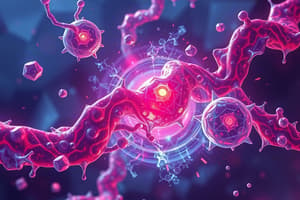Podcast
Questions and Answers
What is produced in the antheridium during spermatogenesis?
What is produced in the antheridium during spermatogenesis?
- Sperm cells (correct)
- Egg cells
- Zygotes
- Spores
Which phase of the cell cycle is referred to as interphase?
Which phase of the cell cycle is referred to as interphase?
- G2 phase only
- G1 phase and S phase only
- M phase only
- G1 phase, S phase, and G2 phase (correct)
What occurs during prophase I of meiosis that contributes to genetic variation?
What occurs during prophase I of meiosis that contributes to genetic variation?
- Crossing over of homologous chromosomes (correct)
- Sister chromatids separating
- Chromosomes misaligning
- Nuclear envelope disintegration
What is the primary outcome of meiosis compared to mitosis?
What is the primary outcome of meiosis compared to mitosis?
Which plant structures produce male and female gametes, respectively?
Which plant structures produce male and female gametes, respectively?
What role do enzymes play in chemical reactions?
What role do enzymes play in chemical reactions?
What is the primary difference between the lock and key model and the induced fit model of enzyme action?
What is the primary difference between the lock and key model and the induced fit model of enzyme action?
Which of the following accurately describes meiosis?
Which of the following accurately describes meiosis?
What occurs during fertilization?
What occurs during fertilization?
Which of the following statements correctly characterizes sexual reproduction?
Which of the following statements correctly characterizes sexual reproduction?
Study Notes
Enzymes
- Enzymes are proteins that accelerate chemical reactions by lowering activation energy.
- Activation energy is the minimum energy needed for a reaction to occur.
- Enzymes bind to a substrate, the reactant, at the active site.
- Binding forms an enzyme-substrate complex, which can occur through the lock-and-key or induced fit model.
- In the lock-and-key model, the enzyme and substrate fit perfectly together, while in the induced fit model, the enzyme changes shape to accommodate the substrate.
- After binding, the enzyme facilitates product formation and releases it, remaining unchanged to bind with more substrate.
Reproduction
- Reproduction can be sexual or asexual.
- Asexual reproduction results in offspring genetically identical to the parent.
- Sexual reproduction involves two parents and results in offspring with a combination of parental genes.
- Mitosis is a type of cell division used in asexual reproduction, creating two identical daughter cells from a parent cell.
- Meiosis is used for sexual reproduction, producing gametes (sex cells) with half the genetic information of the parent cell.
- Male gametes are spermatocytes, and female gametes are oocytes.
- Fertilization occurs when a male and female gamete fuse, forming a zygote with a complete set of parental DNA.
Plants
- The antheridium is the male reproductive organ in many plants, producing sperm cells through spermatogenesis.
- Archegonia are female gametophytes that produce egg cells.
- Gametophytes are the haploid (n) sexual phase in the alternation of generations life cycle.
- Antheridia are found in Bryophytes and cryptogams, which are non-flowering plants that reproduce via spores.
- Ferns are seedless vascular plants that are also cryptogams, with true leaves, roots, and stems.
- Plants alternate between a sexual (gametophyte) phase and an asexual (sporophyte) phase during the life cycle.
- The antheridium releases sperm cells, which requires water for them to swim to the egg in the archegonium.
- Fertilization results in a diploid (2n) zygote, which develops into a sporophyte and produces spores.
Cell Division
- Mitosis divides somatic (body) cells into two identical daughter cells.
- Mitosis occurs in four phases: prophase, metaphase, anaphase, and telophase.
- During prophase, the nuclear envelope disintegrates, and chromosomes become visible.
- Meiosis divides reproductive cells into four genetically distinct daughter cells.
- Meiosis consists of two rounds of division, Meiosis I and Meiosis II.
- During prophase I, homologous chromosomes pair up and exchange genetic information through crossing over.
The Cell Cycle
- The cell cycle describes the process of cell division in living organisms.
- The cell cycle consists of interphase, mitosis, and cytokinesis.
- Interphase prepares the cell for mitosis by growing and replicating its DNA.
- Mitosis divides the cell's nucleus into two identical nuclei.
- Cytokinesis divides the cell's cytoplasm, creating two daughter cells.
- G1 is the first stage of interphase, involving cell growth and basic metabolism.
- The S stage is where DNA is replicated.
- G2 is the last stage of interphase and involves production of organelles and intracellular materials.
- Mitosis has five steps: prophase, prometaphase, metaphase, anaphase, and telophase and cytokinesis.
Errors and Variations in Mitosis
- Errors during mitosis can cause aneuploidy (incorrect number of chromosomes), nondisjunction (failure of chromosomes to separate properly), and trisomy (three copies of a chromosome).
- Endoreplication is a variation of mitosis where a cell retains four copies of each chromosome but does not divide.
- Endoreplication occurs in certain organisms in response to environmental stressors.
Studying That Suits You
Use AI to generate personalized quizzes and flashcards to suit your learning preferences.
Description
Explore the fascinating topics of enzymes and reproduction in this quiz. Understand how enzymes function to accelerate reactions and the differences between sexual and asexual reproduction. Test your knowledge on enzyme models and cell division processes.



